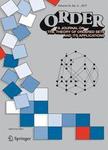版权所有:内蒙古大学图书馆 技术提供:维普资讯• 智图
内蒙古自治区呼和浩特市赛罕区大学西街235号 邮编: 010021

作者机构:STANFORD UNIVDEPT COMP SCISTANFORDCA 94305 IBM RESALMADEN RES CTRSAN JOSECA 95120
出 版 物:《ORDER-A JOURNAL ON THE THEORY OF ORDERED SETS AND ITS APPLICATIONS》 (序;有序集理论杂志)
年 卷 期:1988年第5卷第2期
页 面:131-141页
核心收录:
学科分类:07[理学] 0701[理学-数学] 070101[理学-基础数学]
主 题:Primary 06A10 Secondary 68R99 68Q20 Partially ordered set bump number linear extensions two-processor scheduling
摘 要:Let (X, x 1, x 2, ... has a bump whenever x ix i+1, and it has a jump whenever x iand x i+1are incomparable. The problem of finding a linear erxtension that minimizes the number of jumps has been studied extensively; Pulleyblank shows that it is NP-complete in the general case. Fishburn and Gehrlein raise the question of finding a linear extension that minimizes the number of bumps. We show that the bump number problem is closely related to the well-studied problem of scheduling unit-time tasks with a precedence partial order on two identical processors. We point out that a variant of Gabow s linear-time algorithm for the two-processor scheduling problem solves the bump number problem. Habib, M?hring, and Steiner have independently discovered a different polynomial-time algorithm to solve the bump number problem.